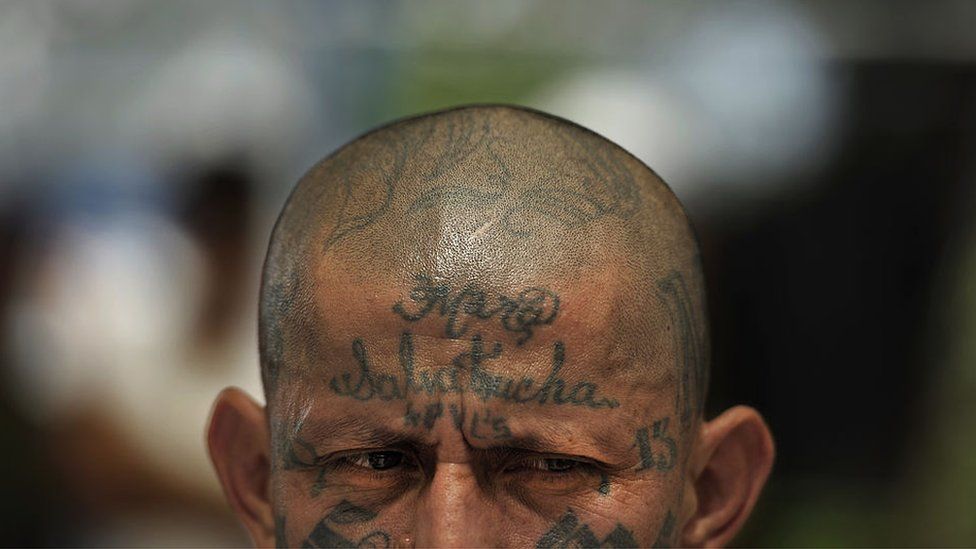MS-13 gang: The story behind one of the world's most brutal street gangs
- Published

A string of brutal murders in the US has thrown a national spotlight on MS-13, a street gang that was born in LA but has roots in El Salvador.
The latest was a mass murder on Monday on Long Island, where the bodies of four males, including three teenagers, were found mangled in the woods, according to police.
President Trump tweeted to call the gang "bad". Attorney General Jeff Sessions vowed to "devastate" it. Both blamed Obama-era immigration policy for its rise.
But what is MS-13 and is Obama really to blame?
A reputation for extreme violence
The gang began in the barrios of Los Angeles in LA during the 1980s, formed by immigrants who had fled El Salvador's long and brutal civil war. Other members came from Honduras, Guatemala and Mexico.
The MS stands for Mara Salvatrucha, said to be a combination of Mara, meaning gang, Salva, for Salvador, and trucha, which translates roughly into street smarts. The 13 represents the position of M in the alphabet.
MS-13 established a reputation for extreme violence and for killing with machetes. It took root in neighbourhoods dominated by Mexican gangs, and later expanded to other parts of the country.
According to the FBI, the gang has spread to 46 states.
In 2012, the US Treasury designated the gang a "transnational criminal organisation". It was the first street gang to receive the dubious honour, placing it alongside much larger international cartels like the Mexican Zetas, Japanese Yakuza and Italian Camorra.
Brutal initiations
MS-13 has been accused of recruiting poor and at-risk teenagers. Joining is said to require being "jumped in" - subjected to a vicious 13-second beating - and "getting wet" - carrying out a crime, often a murder, for the gang.
Leaving is potentially even more dangerous. Large chest tattoos brand members for life, and some factions are said to murder members who attempt to leave.
A 2008 FBI threat assessment put the size of MS-13 between 6,000 and 10,000 members in the US, making it one of the largest criminal enterprises in the country.
It is now larger outside the country, according to the agency. An anti-gang crackdown in the late 1990s saw hundreds of early members shipped back to Central American countries, where they established offshoots. Estimates put the number of members in Central American countries at at least 60,000.
The gang's annual revenue is about $31.2m (£23.4m) according to information from a large-scale Salvadorean police operation obtained by the El Faro newspaper - mainly from from drugs and extortion.
'Kill, rape, control'
Recent high-profile cases linked to the gang include the murder of two female high-school students who were attacked with a machete and baseball bat as they walked through their neighbourhood in New York last month - a revenge attack over a minor dispute, according to police.
Four alleged MS-13 members were charged with that crime. Another two alleged members were charged at the same time with the murder of a fellow gang member said to have violated gang protocol.
Inside El Salvador's Ciudad Barrios prison
The same month, two alleged members of the gang in Houston, Texas were charged with kidnapping three teenage girls, holding them hostage and raping them before shooting one dead on the side of the road.
Miguel Alvarez-Flores, 22, and Diego Hernandez-Rivera, 18, laughed and waved at the cameras during their court appearance.
MS-13's motto is "kill, rape, control", according to one FBI gang specialist who investigated the group.
Blaming Obama
Mr Trump and Mr Sessions have pointed the finger at former President Barack Obama over the spread of MS-13, alleging that his open-door immigration policies fuelled its growth.
But the gang formed and flourished in the US long before Mr Obama came to power. MS-13 was identified as a significant threat in the 1990s, and a special FBI taskforce was convened against the gang in 1994.
"The big surge was during Bush-Cheney when the drivers of illegal migration in Central America grew, when various crackdowns on crime filled prisons to bursting point, and when funding for rehabilitation programs declined," Fulton T Armstrong, a research fellow at the Center for Latin American and Latino Studies at American University, told fact-checking website Politifact.
"I have seen no evidence that the Obama administration can be blamed in any way for the existence or activities of the gang in the US," said Ioan Grillo, author of a book on US gang crime.
The Obama administration also prioritised the deportation of gang criminals, including MS-13 members, in an aggressive deportation program.
Politifact rated Mr Trump's claim as false.
- Published20 November 2012
- Published12 October 2012
- Published3 March 2017